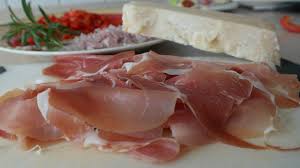One of my favorite memories of drinking Lambrusco happened many years ago during Vinitaly. After a busy morning of tasting Brunellos and Proseccos, we left the show early and headed for lunch on a sunny patio in Verona’s centro storico. As plates of culatello (cured ham from Parma) and bottles of chilled, frothy Lambrusco kept flowing, I thought to myself “can it get any better?” Needless to say, I was hooked on this refreshing, earthy sparkling wine.
This article will explain what Lambrusco is, what you should look for when buying Lambrusco and why it is so sadly misunderstood.
What is Lambrusco?
Lambrusco is an Italian red or rose sparkling wine made from Lambrusco grapes. It can be dry or sweet, but dry versions are usually what you will find in the trattorias of Emilia Romagna, where Lambrusco is produced. There are sweet versions, and much of this is exported to America and Northern Europe.
The export boom began in the 1970’s. For those old enough to remember, The Price Is Right game show sponsors included Rice a Roni (the San Francisco treat) and Riunite Lambrusco (Riunite on ice that’s nice). That version was mostly pink, sickly sweet, low in alcohol and always cheap. Sadly, production of this style is still going strong today at about 125 million bottles per year. No wonder so many people snub their nose at the mere mention of Lambrusco…
The truth is that Lambrusco can be a serious wine, worthy of consideration by wine lovers. It is one of the best “food wines” available and can be served as an aperitif, with appetizers, with main courses and, certain sweeter versions, with desserts. Not many other wines can boast this kind of versatility.
Interestingly, Lambrusco’s fizz is generally not created using the traditional method (second fermentation in bottle) but rather using the Charmat method (tank) like Prosecco. Some smaller artisan producers have been experimenting with the traditional method, but most agree that the tank method preserves the essence and terroir flavours of the grape.
One Name, Many Grape Varieties
Lambrusco is not a single grape variety, but an umbrella name for as many as 15 different red grapes that are not clones or mutations but different varieties with broadly similar characteristics. They originated in the Italian province of Emilia Romagna, and like many Italian grapes they are high in acid and tannin. They became popular because they yield heavily – producing almost three times more fruit per vine than most varieties. It requires significant work in the vineyard to reduce yields and produce superior grapes. The most high-quality Lambrusco varieties are Salumino, Grasparossa and Sorbara. These will be discussed in more detail below. Lambrusco Maestri, Marani and Montericco are also widely planted, but these tend to produce lower quality fruit and go into making some of the larger commercial versions of Lambrusco wine.
Places where Lambrusco varieties grow best have had DOC’s (appellations) created, named after the quality Lambrusco varieties and centered on a particular town or area. Lambrusco Salumino di Santa Croce, Lambrusco di Sorbara and Lambrusco Grasparosso di Castelvetro display the best characteristics of their varietal. Other appellations for Lambrusco include Lambrusco di Modena and Lambrusco di Reggiano, and these appellations can use any of the various Lambrusco varieties.
Lambrusco Salumino
This variety is so-named because of the salami shaped grape clusters. It is deeply coloured, but fairly light in body with a delicate fruity bouquet and wild berry fruit flavours. It has good tannins and acidity. Lambrusco di Salumino is the largest of the DOCs with 2,532 hectares planted. It needs to have a minimum of 85% Salumino, with Ancellotta or other Lambrusca varieties making up the remaining 15%.
Lambrusco Grasparossa
Lambrusco Grasparossa is the most tannic of the Lambrusco varieties. It is relatively low yielding, which produces a more complex and rich wine. Wines made from this variety are a deep ruby, with flecks of purple, especially in the froth. They have relatively soft acidity, with good tannin structure and have intense ripe dark forest fruit flavours. Production is centered around the town of Castelvettro in southern Modena. The best vineyards are on hillsides forcing the vine to work hard for water and ultimately producing concentrated flavours. Lambrusco Grasparossa di Castelvetro needs a minimum of 85% of Grasparossa, with the remaining made up of any of the other authorized grapes.
Lambrusco Sorbara
Of the three main Lambrusco varieties, this variety is usually considered to be the most delicate. It is known for its light ruby colour, floral aromas and tart strawberry flavours. The main characteristic is its difficulty flowering. It drops its flowers during this key point in the vineyard cycle, which reduces the number of bunches and therefore increases concentration of the remaining grapes. To counter this problem, it is usually planted with Salumino to help pollinate the Sorbara vines. The DOC Lambrusco di Sorbara, therefore needs to have a minimum of 60% Sorbara, but can have up to 40% Salumino in the blend.
Lambrusco and Gastronomia

Italian wine is meant to be consumed with food. And wines from Emilia Romagna, the food capital of Italy, are no exception. Food and wine pairings with Lambrusco can be transcendent. Prosciutto and formaggio from Parma, mortadella from Bologna, balsamic vinegar from Modena… the amazing array of foods produced in Emilia Romagna echo the notes of Lambrusco: tangy, zesty, earthy. It can cut through the fat, handle the salt and refresh the palate.
Try Lambrusco di Sorbara as an aperitif because of its elegant nature and fresh style. Lambrusco Salumino will pair well with sausages and lentils or Parmigiano Reggiano. Lambrusco Grasparossa is full enough to stand up to roasted meats, but also pairs with all types of stuffed pasta and lasagna.
For dessert, pastries and fresh fruit can also work with Lambrusco, especially if you have a slightly sweet version which would have the word Amabile on the label.
The Best Lambrusco to Buy
Finding a high-quality Lambrusco in Ontario can be difficult. However, this wine is becoming much more popular as consumers look to expand their wine horizons.

